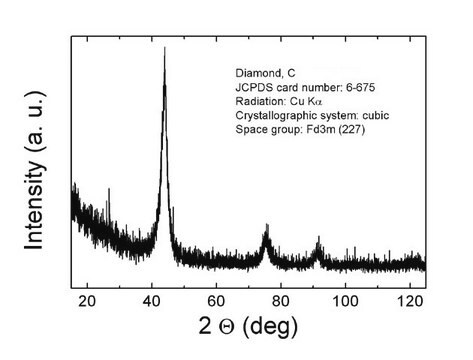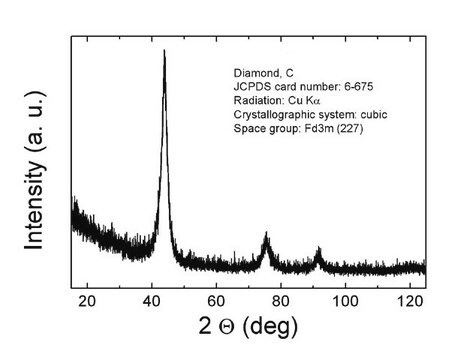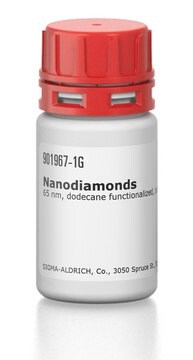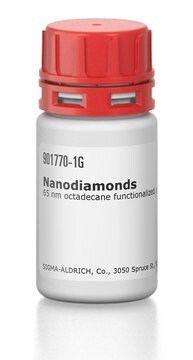483591
Diamant
synthetic monocrystalline powder, ≤1 μm
Anmeldenzur Ansicht organisationsspezifischer und vertraglich vereinbarter Preise
Alle Fotos(1)
About This Item
Empirische Formel (Hill-System):
C
CAS-Nummer:
Molekulargewicht:
12.01
EG-Nummer:
MDL-Nummer:
UNSPSC-Code:
12352103
NACRES:
NA.23
Empfohlene Produkte
Form
synthetic monocrystalline powder
Qualitätsniveau
Partikelgröße
≤1 μm
Dichte
3.5 g/mL at 25 °C (lit.)
Anwendung(en)
battery manufacturing
Suchen Sie nach ähnlichen Produkten? Aufrufen Leitfaden zum Produktvergleich
Verwandte Kategorien
Anwendung
Monocrystalline diamond particles internalized in human endothelial cells have potential applications in drug delivery.
Lagerklassenschlüssel
11 - Combustible Solids
WGK
nwg
Flammpunkt (°F)
Not applicable
Flammpunkt (°C)
Not applicable
Persönliche Schutzausrüstung
Eyeshields, Gloves, type N95 (US)
Hier finden Sie alle aktuellen Versionen:
Besitzen Sie dieses Produkt bereits?
In der Dokumentenbibliothek finden Sie die Dokumentation zu den Produkten, die Sie kürzlich erworben haben.
Micron-sized diamond particles are internalized by endothelial cells.
Walkowiak B, et al.
Diamond and Related Materials, 18, 651-656 (2009)
Pontus Forsberg et al.
Optics express, 21(3), 2693-2700 (2013-03-14)
Control of the sidewall angle of diamond microstructures was achieved by varying the gas mixture, bias power and mask shape during inductively coupled plasma etching. Different etch mechanisms were responsible for the angle of the lower and upper part of
P Pereira Nogueira et al.
The Journal of clinical pediatric dentistry, 37(1), 53-57 (2013-01-25)
The aim of the present study was to evaluate hybrid layer thickness of primary molars sectioned with diamond, carbide and ultrasonic CVD burs. The occlusal enamel surfaces often molars were removed and superficial dentin was exposed. Three standardized cavities were
H Pinto et al.
Journal of nanoscience and nanotechnology, 12(11), 8589-8593 (2013-02-21)
We have investigated using density functional theory the effect of fluorine termination of a (001) diamond surface on the electronic energy levels of an NV- centre buried beneath the surface. We find that, like OH termination, fluorine passivates the surface
Richard W Bowman et al.
Physical review letters, 110(9), 095902-095902 (2013-03-19)
Diamond anvil cells allow the behavior of materials to be studied at pressures up to hundreds of gigapascals in a small and convenient instrument. However, physical access to the sample is impossible once it is pressurized. We show that optical
Global Trade Item Number
| SKU | GTIN |
|---|---|
| 483591-1G | |
| 483591-5G | 4061832390062 |
Unser Team von Wissenschaftlern verfügt über Erfahrung in allen Forschungsbereichen einschließlich Life Science, Materialwissenschaften, chemischer Synthese, Chromatographie, Analytik und vielen mehr..
Setzen Sie sich mit dem technischen Dienst in Verbindung.







